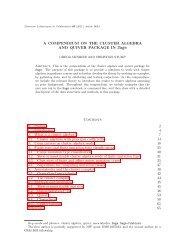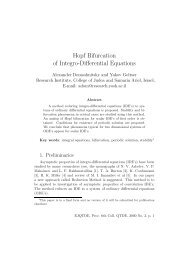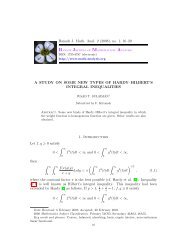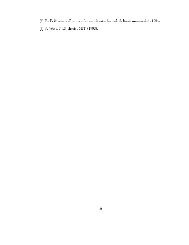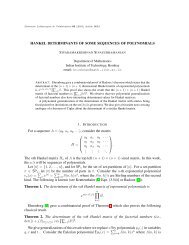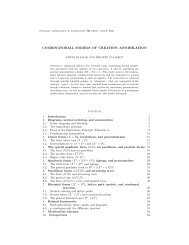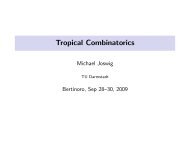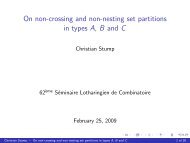Banach J. Math. Anal. 4 (2010), no. 2, 37–44 FUNCTIONAL ... - EMIS
Banach J. Math. Anal. 4 (2010), no. 2, 37–44 FUNCTIONAL ... - EMIS
Banach J. Math. Anal. 4 (2010), no. 2, 37–44 FUNCTIONAL ... - EMIS
Create successful ePaper yourself
Turn your PDF publications into a flip-book with our unique Google optimized e-Paper software.
<strong>Banach</strong> J. <strong>Math</strong>. <strong>Anal</strong>. 4 (<strong>2010</strong>), <strong>no</strong>. 2, <strong>37–44</strong><br />
<strong>Banach</strong> Journal of <strong>Math</strong>ematical <strong>Anal</strong>ysis<br />
ISSN: 1735-8787 (electronic)<br />
www.emis.de/journals/BJMA/<br />
<strong>FUNCTIONAL</strong> HOMOMORPHISMS AND DYNAMICAL<br />
SYSTEMS<br />
R.K. SINGH 1∗ , P. SINGH 2 AND V.K. PANDEY 3<br />
Communicated by S.-M. Jung<br />
Abstract. This article presents an interaction between functional homomorphisms,<br />
dynamical systems and differential equations. The exponential functions<br />
play pivotal role in this interaction.<br />
1. Introduction<br />
Let X and Y be topological rings. Then consider the following four types of<br />
mappings from X to Y .<br />
(1) h1 : X → Y such that h1(x + y) = h1(x) + h1(y)<br />
(2) h2 : X → Y such that h2(x + y) = h1(x).h2(y)<br />
(3) h3 : X → Y such that h3(x.y) = h1(x) + h2(y)<br />
(4) h4 : X → Y such that h4(x.y) = h4(x).h4(y), for every x, y ∈ X.<br />
These mapping are homomorphisms under different (or same) algebraic operations<br />
on X and Y . For example, a mapping satisfying (1) and (4) is a ring<br />
homomorphism. If it satisfies only (1), then it is a group homomorphism from<br />
(X, +) to (Y, +). The mapping satisfying (2) is a homomorphism from the additive<br />
group (X, +) to multiplicative semigroup (Y, ·). These types of mappings<br />
and their combinations give rise to what is k<strong>no</strong>wn as functional equations in<br />
Date: Received: 20 July 2009; Revised: 19 September 2009; Accepted: 1 December 2009.<br />
∗ Corresponding author.<br />
2000 <strong>Math</strong>ematics Subject Classification. Primary 47D03; Secondary 39B42, 37C60.<br />
Key words and phrases. Functional homomorphisms, dynamical system, generator of a semigroup,<br />
abstract Cauchy problem.<br />
The work was partially supported by the research grant No. SR/MS:471/07 from Department<br />
of Science and Tech<strong>no</strong>logy, Government of India.<br />
37
38 R.K. SINGH, P. SINGH, V.K. PANDEY<br />
analysis and they have connections with several areas of mathematics and mathematical<br />
physics. They have been the subject matter of study for the last two<br />
centuries or so and a lot of mathematics has been developed around them. The<br />
homomorphisms of type (2) are of special significance as they make contact with<br />
time dependent systems describing changes in nature. In this article we shall<br />
restrict our attention to this type of homomorphisms. By a functional homomorphism<br />
we shall mean a function f : X → Y satisfying to the equation (F H)<br />
f(x + y) = f(x)f(y) for every x, y ∈ X. A solution of this equation is a homomorphism<br />
from additive group (X, +) to multiplicative semigroup (Y, ·). In order<br />
to have more fruitful interactions with application oriented mathematics we shall<br />
consider only continuous homomorphisms, i.e. continuous functions from X to Y<br />
satisfying (F H). In this article, which is expository in nature, we shall describe a<br />
relation between functional homomorphisms, semigroups of operators on <strong>Banach</strong><br />
spaces and dynamical systems.<br />
2. Preliminaries<br />
Let G be a topological group with e as the identity, let X be a topological<br />
space and π : G × X → X be a continuous map such that<br />
(1) π(e, x) = x for every x ∈ X<br />
(2) π(st, x) = π(s, π(t, x)) for every s, t ∈ G and x ∈ X<br />
Then the triple (G, X, π) is called a transformation group, X is called the state<br />
space (or phase space) and π is called an action or a motion on X. For x ∈ X,<br />
let the map πx : G → X be defined as πx(t) = π(t, x) for every t ∈ G. Then<br />
πxis called the motion through x and the range of πx is called the orbit of x.Thus<br />
orbit x = {π(t, x) : t ∈ G}. For t ∈ G define the map πt : X → X as πt (x) =<br />
π(t, x) for every x ∈ X. The map πt is a homeomorphism and (πt ) −1 = πt−1. The set {π t : t ∈ G} is a subgroup of the group of all homeomorphisms of X.<br />
The study of motions, orbits and orbit spaces comes under topological dynamics<br />
[2]. If G = (R, +) or G = (Z, +), the corresponding transformation group is<br />
called a dynamical system. The transformation group (R, X, π) is k<strong>no</strong>wn as<br />
continuous dynamical system, whereas (Z, X, π) is called a discrete dynamical<br />
system. It is well k<strong>no</strong>wn that every discrete dynamical system on X comes from<br />
a homeomorphism of X. Thus there is one-to-one correspondence between the<br />
set of all homeomorphisms of X and the set of all discrete dynamical systems<br />
on X. For details see [2]. If R is replaced by R + or Z is replaced by Z + , then<br />
we get a future dependent semidynamical system. Every discrete semidynamical<br />
system comes from a continuous self map of X. In this <strong>no</strong>te our concern is<br />
with semidynamical system on <strong>Banach</strong> spaces which we shall also call dynamical<br />
system. If X is a <strong>Banach</strong> space and π(t, αβ + βy) = απ(t, x) + βπ(t, y), for<br />
t ∈ R, α, β ∈ C and x, y, ∈ X, then (R + , X, π) is called a linear dynamical<br />
system. If X is a <strong>Banach</strong> space, then by B(X) we shall de<strong>no</strong>te the <strong>Banach</strong><br />
algebra of all continuous linear operators on X. If A ∈ B(X), then e tA is defined<br />
as e tA = ∞<br />
n=0<br />
(tA) n<br />
n! . This series is convergent in B(X) and thus e tA ∈ B(X)<br />
for every t ∈ R. If we define, πA : R × X → X as πA(t, x) = etA (x), then<br />
(R + , X, πA) is a linear dynamical system on X. If πd A : Z × X → X is defined
<strong>FUNCTIONAL</strong> HOMOMORPHISMS AND DYNAMICAL SYSTEMS 39<br />
as πd A (m, x) = Am (x), then (Z + , X, πd A ) is a discrete linear dynamical system.<br />
Thus every bounded linear operator on a <strong>Banach</strong> space X induces at least two<br />
dynamical systems. It turns out that most of the linear dynamical systems are<br />
induced by operators. The functional homomorphisms play important role in this<br />
process. By a semigroup of operators on a <strong>Banach</strong> space X, we mean a functional<br />
homomorphism T : R + → B(X) such that T (0) = I, the identity operator. The<br />
range {T (t) : t ≥ 0} of T is a multiplicative abelian semigroup of B(X). The<br />
semigroup T is called c0−semigroup if it is continuous with respect to the strong<br />
operator topology on B(X). If T is continuous with respect to <strong>no</strong>rm topology on<br />
B(X), then it is called uniformly continuous semigroup. Usually, a semigroup T<br />
is de<strong>no</strong>ted as {T (t) : t ≥ 0}, which is <strong>no</strong>thing but the image of T in B(X). It is a<br />
family of bounded operators {Tt : t ≥ 0} on X such that T0 = I and Ts+t = TsTt<br />
for s, t ∈ R + . If A ∈ B(X), and T (t) = etA , then T is a c0−semigroup on<br />
X. Every c0−semigroup T on X gives rise to a dynamical system, where action<br />
is given by πT (t, x) = T (t)(x) = Tt(x) for t ∈ R + and x ∈ X If A ∈ B(X),<br />
then the following initial value problem is k<strong>no</strong>wn as Abstract Cauchy Problem.<br />
d<br />
dtx = Ax, x(0) = x0 Here x is a differentiable function from R + to X. If A is the<br />
generator of a c0− semigroup T : R + → B(X), then x(t) = T (t)x0 is a solution<br />
of the Abstract Cauchy Problem.<br />
3. Some classical Solutions of (FH)<br />
In 1821, A. Cauchy made study of functional homomorphisms from R to C.<br />
He suggested that all such homomorphisms are exponential functions. In the<br />
following theorem we record the result of A. Cauchy.<br />
Theorem 3.1. (A. Cauchy) If T : R → C is a continuous functional homomorphism,<br />
such that T (0) = 1, then there exists a ∈ C, such that T (t) = eat for every t ∈ R. It is clear that the T (t) = eat is a functional homomorphism<br />
and satisfies the initial-value problem, d T = aT, T (0) = 1. These are the only<br />
dt<br />
functions satisfying the initial value problem and a = T ´ (0), where T ´ de<strong>no</strong>tes the<br />
derivative of T .<br />
Note. Every continuous functional homomorphism from R + to C is also differentiable.<br />
The above result of Cauchy is true for all continuous functional<br />
homomorphisms from the additive group C to multiplicative group C\{0}. Every<br />
functional homomorphism T gives rise to dynamical system, where orbit of a<br />
state x0 ∈ C is given by {T (t)x0 : t ∈ R}.<br />
4. Functional homomorphisms in higher dimensions<br />
The result of the last section has been extended to higher dimensions. Let<br />
X = C n , the n−dimensional <strong>Banach</strong> space of n−tupples of complex numbers<br />
with the pointwise vector operations and the usual <strong>no</strong>rm. Let A be an n × n ma-<br />
trix. then A is a bounded linear operator from the C n to C n . Let Bn(C) de<strong>no</strong>te<br />
the <strong>Banach</strong> algebra of all n×n matrices with operator <strong>no</strong>rm, i.e. A = sup<br />
x=0<br />
Ax<br />
x .
40 R.K. SINGH, P. SINGH, V.K. PANDEY<br />
If A ∈ Bn(C), then e tA is also a matrix given by e tA =<br />
n=0<br />
to compute the matrix etA If A is a diagonal matrix with diagonal (α1,α2, . . . αn),<br />
then etA is also a diagonal matrix with diagonal (eα1t α2t αnt , e , . . . . . . , e ). If A =<br />
∞<br />
(tA) n<br />
n! . It is very difficult<br />
<br />
0 1<br />
then e<br />
−1 0<br />
tA <br />
cos t sin t<br />
is rotational matrix<br />
. The matrix e<br />
− sin t cos t<br />
tA for every<br />
A ∈ B2(C) has been computed [3]. Let T : R → Bn(C) be a functional homomorphism<br />
taking 0 to the identity matrix I. Then the same question regarding<br />
characterization of such homomorphisms can be asked, i.e. find all continuous<br />
functional homomorphisms T : R → Bn(C). This question was answered in 1887<br />
by Pea<strong>no</strong>. This is recorded in the following theorem.<br />
Theorem 4.1. (Pea<strong>no</strong>). Let T : R → Bn(C) be a continuous functional homomorphism<br />
such that T (0) = I. Then there exists a unique A ∈ Bn(C) such<br />
that T (t) = etAfor every t ∈ R. Futhermore, T is differentiable function and is a<br />
solution of d T = AT, T (0) = I and any solution of the above initial value problem<br />
dt<br />
is of this type [3]<br />
Let (R, Cn , π) be a linear dynamical system. For every t ∈ R, define the map<br />
πt : Cn → Cn by πt (x) = π(t, x) for x ∈ Cn . Then πt is a linear operator on Cn ,<br />
i.e. πt is an invertible n × n matrix. Let T : R → Bn(C) be defined as T (t) = πt ,<br />
for t ∈ R. Then T is a functional homomorphism T (t) = etA for some unique<br />
A. It is interesting to <strong>no</strong>te that the set of functional homomorphisms, the set<br />
of linear dynamical systems on Cn , and the set of solutions of the initial value<br />
problem d<br />
dtT = AT, T (0) = I, A ∈ Bn(C), are equipotent and they are closely<br />
related. Let T : R → Bn(C) be a continuous functional homomorphism, let<br />
πT : R × Cn → Cn be defined as πT (t, x) = T (t)x. Then πT is a linear dynamical<br />
system. Conversely, every linear dynamical system on Cn is of this type. This we<br />
shall show in the following theorem,<br />
Theorem 4.2. (a) Let π : R × Cn → Cn be a continuous map. Then (R, Cn , π)<br />
is a linear dynamical system if and only if there exists a continuous functional<br />
homomorphism T : R → Cn such that π = πT .<br />
(b) Every continuous functional homomorphism T : R → Bn(C) is the only<br />
solution of d T = AT, T (0) = I where A = T´(0).<br />
dt<br />
(c) A solution of the initial value problem gives rise to a linear dynamical<br />
system on Cn .<br />
Proof. (a) If π is a motion on Cn , then let πt : Cn → Cn , defined as πt (x) = π(t, x)<br />
is a linear operator on Cn and hence πt ∈ Bn(C). Let T : R → Bn(C) be<br />
defined as T (t) = πt . Then T is a continuous functional homomorphism and<br />
πT (t, x) = T (t)x = πt (x) = π(t, x) for all t ∈ R and x ∈ X. Hence π = πT . The<br />
converse is obvious.<br />
(b) If T : R → Bn(C) is a continuous homomorphism, then result follows<br />
from Pea<strong>no</strong>’s theorem. Consider the initial value problem, d T = AT, T (0) = I,<br />
dt<br />
A ∈ Bn(C). By Pea<strong>no</strong>’s theorem we k<strong>no</strong>w that T (t) = etA is a solution of the<br />
initial value problem. Let π = πT Then π is a motion on Cn and u(t) = etAx0
<strong>FUNCTIONAL</strong> HOMOMORPHISMS AND DYNAMICAL SYSTEMS 41<br />
is the orbit function of state x0 and satisfies the Abstract Cauchy Problem on<br />
Cn , d u = Au, u(0) = x0.<br />
dt<br />
Note. The above results are valid for n−dimensional <strong>Banach</strong> spaces also.<br />
5. Functional homomorphisms in infinite dimensional <strong>Banach</strong><br />
spaces<br />
In this section we assume that X is an infinite dimensional <strong>Banach</strong> space. There<br />
are three nice operator topologies on B(X), namely uniform operator topology,<br />
strong operator topology and weak operator topology. To include a larger class<br />
of functional homomorphisms we shall take their domain as R + , the semigroup<br />
of positive reals with usual topology. If T : R + → B(X) is a functional homomorphism,<br />
then uniform, strong and weak operator topologies on B(X) give rise<br />
to three continuities of T, namely uniform continuity, strong continuity and weak<br />
continuity. The characterization of uniformly continuous functional homomorphisms<br />
is similar to the finite dimensional case . This is given in the following<br />
theorem.<br />
Theorem 5.1. Let X be any <strong>Banach</strong> space and let T : R + → B(X) be a uniformly<br />
continuous functional homomorphism with T (0) = I. Then there exists a unique<br />
A ∈ B(X) such that<br />
(a) T : R + → B(X) is differentiable<br />
(b) T (t) = etA for every t ∈ R +<br />
(c) The orbit function u : R + → X, given by u(t) = T (t)x is differentiable for<br />
every x ∈ X and satisfies the initial value problem, du = Au, u(0) = x<br />
dt<br />
An outline of the proof.<br />
If T is uniformly continuous, then the operator S(t), given by S(t) =<br />
is invertible for small t. Now T (t) = S(t0) −1 S(t0)T (t) = S(t0) −1<br />
t+t0 <br />
t<br />
t<br />
0<br />
T (s)ds<br />
T (s + t)ds<br />
for t ≥ 0. Now d T (t) = lim<br />
dt<br />
h→0 +<br />
T (t+h)−T (t)<br />
= T´(0)T (t). This shows that T is<br />
h<br />
differentiable and satisfies the differential equation d<br />
dt<br />
T (t) = AT, T (0) = I, where<br />
A = T´(0). Hence by uniqueness of solution we have T (t) = e tA . This proves (a)<br />
and(c). The proof of (c) is easy.<br />
Note. The operator A(= T´(0)) is called the generator of the semigroup T .<br />
There is one-to-one correspondence between the set of all uniformly continuous<br />
functional homomorphisms and linear (semi)dynamical systems on X. Thus the<br />
concept of uniformly continuous semigroups is equivalent to linear dynamical systems<br />
on a <strong>Banach</strong> space X. If T : R + → B(X) is strongly continuous functional<br />
homomorphism with T (0) = I, then the generator of T may <strong>no</strong>t be a bounded<br />
operator, and hence representation of T as T (t) = e tA may <strong>no</strong>t be possible as was<br />
done in case T is uniformly continuous. We shall present an analogous characterization<br />
for strongly continuous functional homomorphisms. The (infinitesimal)
42 R.K. SINGH, P. SINGH, V.K. PANDEY<br />
generator A of T : R + → B(X) is defined as Ax = lim<br />
D(A) of A is the set D(A) = {x ∈ X : lim<br />
t→0 +<br />
t→0 +<br />
T (t)x−x<br />
t<br />
T (t)x−x<br />
. Then the domain<br />
t<br />
exists}. A is a linear and<br />
closed operator, <strong>no</strong>t necessarily bounded and D(A) is a dense subspace of X. For<br />
details see [1, 3]. A is called the generator of T . The resolvent set ρ(A) is the set<br />
of all those complex numbers λ such that the operator λI − A : D(A) → X is a<br />
bijection. The spectrum of A, de<strong>no</strong>ted by σ(A) is C\ρ(A). The resolvent operator<br />
R(λ, A) for λ ∈ ρ(A) is defined by R(λ, A) = (λI −A) −1 . By the closed graph theorem<br />
R(λ, A) is a bounded operator. If λ and µ are in ρ(A), then it is easy to show<br />
that (µ − λ)R(λ, A)R(µ, A) = R(λ, A) − R(µ, A). Let T be a strongly continuous<br />
homomorphism from R + to B(X) with T (0) = I and let A be the infinitesimal<br />
generator of T . Let x ∈ D(A). Then the orbit map Tx : R + → X defined as<br />
Tx(t) = T (t)x is differentiable and d<br />
dt Tx(t) = T (t)Ax = AT (t)x (T (t)x ∈ D(A)).<br />
If S is a<strong>no</strong>ther strongly continuous homomorphism with S(0) = I having the same<br />
infinitesimal generator A, then it turns out that S(t)x = T (t)x for all x ∈ D(A).<br />
Since D(A) is dense, we conclude that S = T . Thus the infinitesimal generator<br />
determine the strongly continuous functional homomorphism uniquely. In case<br />
the infinitesimal generator A is bounded, the strongly continuous functional homomorphism<br />
is uniformly continuous and hence T (t) = e tA for t ∈ R + . For every<br />
strongly continuous functional homomorphism there exists M ≥ 1 and ω ∈ R<br />
such that T (t) ≤ Me ωt for every t ∈ R + [6, 9]. Every strongly continuous functional<br />
homomorphism from R + to B(X) gives rise to a densely defined closed<br />
operator on X, namely its generator. The following theorem characterizes such<br />
operators generating strongly continuous functional homomorphisms.<br />
Theorem 5.2. (Miyadera and Phillips). Let A be a linear operator on a<br />
<strong>Banach</strong> space and let M ≥ 1 and ω ∈ R. Then the following are equivalent.<br />
(a) A generates a strongly continuous homomorphism T : R + → B(X) such<br />
that T (t) ≤ Meωt .<br />
(b) A is closed, densely defined and λ > ω, it is true that λ ∈ ρ(A) and<br />
[(λ − ω)R(λ, A)] n ≤ M for every n ∈ N.<br />
(c) A is closed, densely defined operator and for every complex number λ such<br />
that Re λ > ω, it is true that λ ∈ ρ(A) and R(λ, A) n M ≤ (Re λ−ω) n for every<br />
n ∈ N.<br />
Note. The above theorem is a generalization of famous Hille–Yosida theorem<br />
proved in 1948 [4], which characterizes strongly continuous functional homomorphisms.<br />
If {An} is a sequence of bounded operators on X such that lim n Anx = Ax,<br />
for every x ∈ D(A), then the generalized exponential function for A is defined as<br />
e tA = lim n e tAn and it may give rise to a strongly continuous functional homomor-<br />
phism. This generalization of exponential function for unbounded operator on<br />
X help in giving the following characterization of strongly continuous functional<br />
homomorphisms [3].<br />
Theorem 5.3. Let T : R + → B(X) be a strongly continuous function. Then T<br />
is a functional homomorphism with T (0) = I and T (t) ≤ 1, if and only if
<strong>FUNCTIONAL</strong> HOMOMORPHISMS AND DYNAMICAL SYSTEMS 43<br />
T (t) = e tA for some closed, densely defined operator A on X with property that<br />
λ > 0 implies λ ∈ ρ(A) and λR(λ, A) ≤ 1.<br />
An outline of the proof.<br />
If T : R + → B(X) is a strongly continuous homomorphism with T (0) = I,<br />
then infinitesimal generator A of T is closed, densely defined operator on X with<br />
the property given above. If An = nAR(n, A), then An is a bounded operator on<br />
X and e tAn ∈ B(X) for every t ∈ R + . Let Tn(t) = e tAn . Since An → A pointwise<br />
on D(A), we have T (t)x = lim n Tn(t)x = lim e tAn x = e tA x. Thus T (t) = e tA .<br />
Conversely, If T (t) = e tA for some closed, densely defined operator A, then by<br />
definition of e tA , T (t) = lim n e tAn , where An = nAR(n, A). Since e tAn is uniformly<br />
continuous functional homomorphism and An → A pointwise, we conclude that<br />
T is strongly continuous, T (t + s) = T (t)T (s) and T (0) = I. This takes care of<br />
the outline of the proof. An interaction of strongly continuous homomorphisms,<br />
linear dynamical systems and abstract cauchy problem is given in the following<br />
theorem.<br />
Theorem 5.4. (a) Every strongly continuous homomorphism T : R + → B(X)<br />
gives rise to the linear dynamical system πT on X defined as πT (t, x) = T (t)x for<br />
every t ∈ R + and x ∈ X. Conversely, for every dynamical system π on X, there<br />
exists a strongly continuous homomorphism T : R + → B(X) such that π = πT .<br />
(b) If T : R + → B(X) is a strongly continuous homomorphism and A is infinitesimal<br />
generator of T , then the Abstract Cauchy Problem d u(t) = Au(t), u(0) =<br />
dt<br />
x has a solution given by u(t) = T (t)x.<br />
(c) The Abstract Cauchy Problem has a unique solution if A is densely defined<br />
closed operator with property λ > 0 implies λ ∈ ρ(A) and λR(λ, A) ≤ 1 (i.e.<br />
A is a generator of a strongly continuous homomorphism).<br />
This survey completes the characterization of continuous homomorphisms from<br />
R + → B(X). A lot of work has been done in the last 50 years or so and many<br />
applications of concrete homomorphisms have been obtained. For details we refer<br />
to [5, 7, 8].<br />
Ack<strong>no</strong>wledgement. The work on this article was initiated when the first<br />
author visited University of Massachusetts at Boston and University of Texas<br />
at Austin during the summer of 2008. He is thankful to both Universities for<br />
providing research facilities.<br />
References<br />
[1] C. Chicone and Y. Latushkin, Evolution Semigroups in Dynamical Systems and Differential<br />
Equations, <strong>Math</strong>. Survey mo<strong>no</strong>graph, 70, American <strong>Math</strong>. Soc., Providence, 1999.<br />
[2] R. Ellis, Lectures on Topological Dynamics, Benjamin, N.Y., 1969.<br />
[3] K.J. Engel and R. Nagel, One Parameter Semigroup of Linear Evolution Equations,<br />
Springer-Verlag, New York, Berlin 1999.<br />
[4] J.A. Goldstein, Semigroups of Linear Operators and Applications, Oxford University Press,<br />
Oxford, N.Y. 1985.<br />
[5] J.S. Manhas, Operators and Dynamical Systems on Weighted Function Spaces, Thesis, University<br />
of Jammu, 1990.
44 R.K. SINGH, P. SINGH, V.K. PANDEY<br />
[6] A. Pazy, Semigroup of Linear Operators and Application to Partial Differential Equations,<br />
Springer-Verlag, New York, 1983.<br />
[7] R.K. Singh and J.S. Manhas, Composition Operators on Function Spaces, North-Holland<br />
publishing co., Amsterdam, London, New York, 1993.<br />
[8] A. Siskakis, Semigroups of Composition Operators and the Cezaro Operators on H p , Thesis,<br />
University of llli<strong>no</strong>is, 1985.<br />
[9] J.A. Walker, Dynamical Systems and Evolution Equations, Plenum Press, New York, London,<br />
1980.<br />
1,3 Department of <strong>Math</strong>ematics and Astro<strong>no</strong>my, University of Luck<strong>no</strong>w, Luck<strong>no</strong>w,<br />
U.P. India.<br />
E-mail address: rajkishor@hotmail.com<br />
E-mail address: mr.vineet2007@rediffmail.com<br />
Current address: 2 Hewlett-Packard, 14231 Tandem Blvd, Austin-TX-78728, USA.<br />
E-mail address: pramod.singh@hp.com



